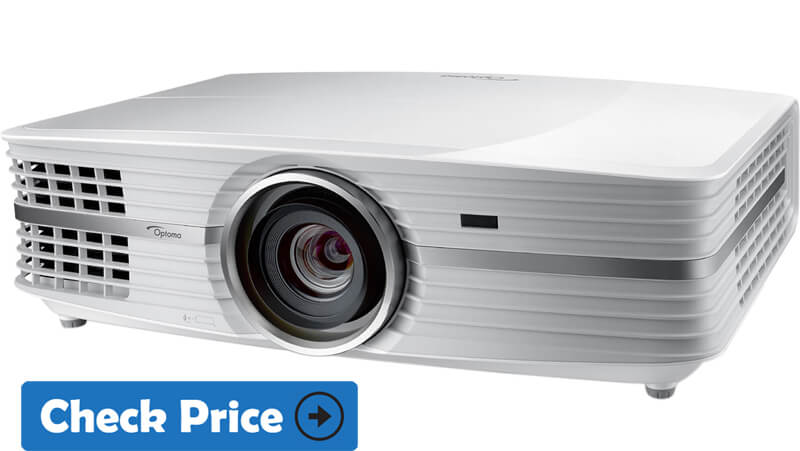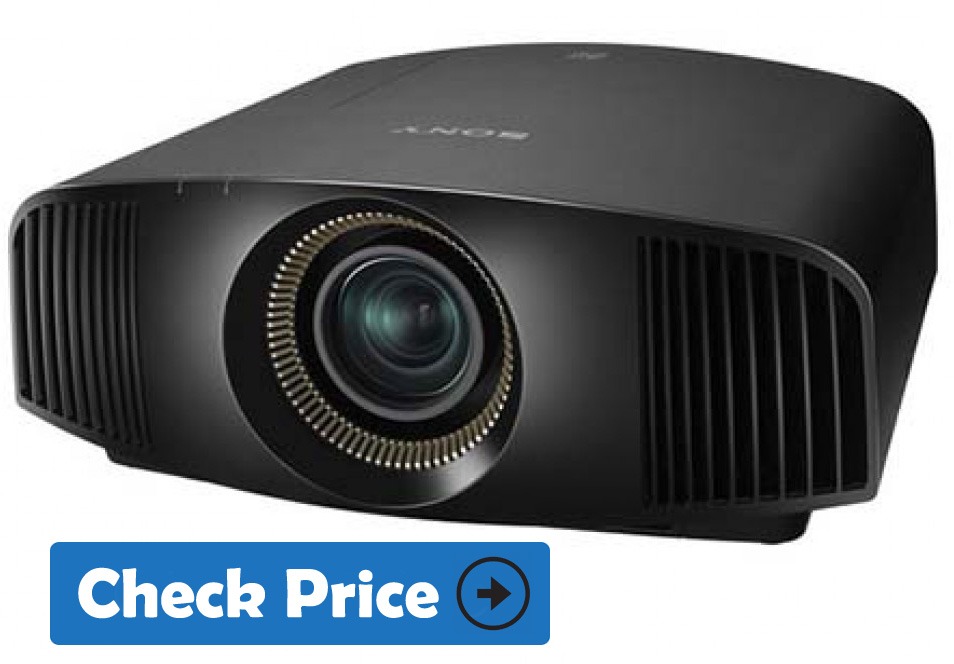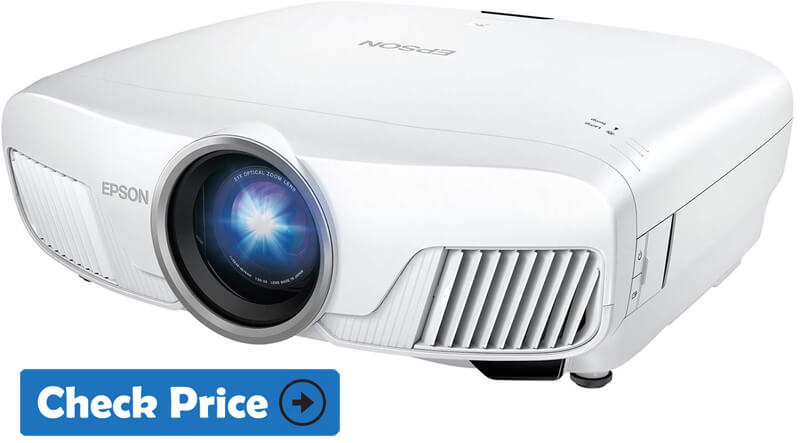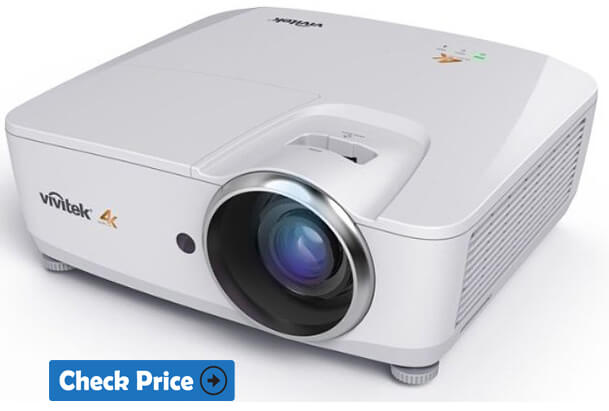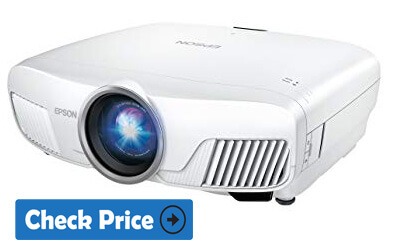Are you looking for the cheapest 4K projector? This guide has been designed to help you make the right choice.
Enjoying a movie at home or at the cinema is a goal for many, the 4K projector is ideal for this purpose. The difference in the quality of the Ultra HD is obvious and this is why it is increasingly contained in this format.
Everything, from video games to movies, through videos that can be recorded even with your own devices, you can enjoy much better in the 4K format.
Obviously, not all 4K projectors are the same. So if you want to buy one you need to know some important aspects before making a choice.
In our guide, you will read all the information you need to find a device that fits your needs and that you can no longer do without to enjoy a good movie.
Read on if you like the idea!
We spent hours analyzing the tests, the opinions of buyers and specialists in the field to provide you with the best 4k projectors models of 2025.
This guide is updated constantly, according to the outputs and updates proposed by the manufacturers.
To facilitate your search we have separated the 4K projectors in 2 ranges, one more affordable than the other, hoping that you will find your happiness.
After the comparison tables, we also present more general and technical information in Buyer’s Guide Section of this post to understand how 4K technology works and what is connected to it …
You have everything you need to make the right choice!
The Best & Inexpensive 4K Projectors 2025
Table of Contents
The 4K (or UHD for Ultra High Definition) has become more popular in the television world in recent years, but it is only a short time since the world of video projectors finally offers 4K devices at affordable prices.
What’s more, when you want to reproduce a cinema atmosphere at home, the video projector brings an experience far beyond television thanks to its image size.
Cheapest 4K Projectors 2025
The term “cheap” is obviously relative because you can not buy a 4K projector without paying several hundred dollars. However, you should know that the price of a UHD video projector can climb up to several thousand dollars.
Thus, it is considered that a 4K video projector around 1000 dollars can be classified in the “cheap” category.
The table below shows the best models of the moment with our preferences.
Cheapest 4K Projectors | Comparison Table 2025
High Quality| 5-Star Rating | Affortable Price
| Projector Name | Display Tech | Lumens | Price $$ |
|---|---|---|---|
| Optoma UHD60 (Editor's Choice) | DLP | 3000 | view on Amazon |
| Sony VPLVW285ES Expensive Projector | LCD | 1500 | view on Amazon |
| Epson 5040UBe | DLP | 2500 | view on Amazon |
| Vivitek HK2288 | DLP | 2000 | view on Amazon |
| Optoma UHL55 Cheapest 4K | DLP | 2500 | view on Amazon |
| Epson Home Cinema 4000 | LCD | 2200 | view on Amazon |
| BenQ TK800 | DLP | 3000 | view on Amazon |
7 Cheapest 4K Projectors of 2025 Products Overview
1. Optoma UHD60 4K Ultra HD Projector (Editor’s Choice)
Key Specifications
About:
As the number one manufacturer of home HD projectors, Optoma offers high-quality, state-of-the-art UHD 4K projectors with UHD60. UHD60 offers a UHD resolution of 3840 x 2160 4K and provides a very sharp image with an impressive image of 8.3 million pixels on the screen.
In addition to a wide range of colors, compatibility with High Dynamic Range (HDR) ensures rich and realistic colors with vibrant whites and deep blacks. The Optoma UHD60 also features vertical lens shift and 1.6x zoom for easy installation.
Design
- The projector releases warm air to the front, with connectivity in the back. There are two HDMI, only one of which is compatible with 4K HDCP 2.2, and there is also a PC VGA input.
- The USB is present, but to feed the Amazon Fire TV and Roku TV Stick apps, rather than multimedia playback. Both digital audio and analog stereo outputs are provided.
- Other connections include an RJ-45 for control and a 12 V trigger to synchronize the projector with an electric projection screen. Comes with a backlit remote control.
Performance
- Watch more videos at 4x the pixels of 1080p HDTV. The higher resolution creates a very sharp image to achieve the best 4K home theater experience.
- With a launch ratio of 1.39 to 2.22 with a 1.6x zoom and vertical lens shift, it can be installed flexibly and easily in various spaces and screen sizes over 140 inches.
- It is Super Bright, the 3,000-lumen is bright enough in any room of the house, whether in a bright living room or a dim home theater space.
Features
- With true UHD 4K resolution, It offers impressive 8.3 million pixel addressable pixels, providing amazing detail and image quality.
- The UHD60 uses HDR10 image technology that can display anything in the REC2025 color space, enabling deep black levels, bright whites, and dark, realistic colors that correspond to the color spaces used in television and movie production.
- On TV, you need to sit 5-6 feet away for optimal image quality-most sit far away. You can reach 10 feet away and see all 4K pixels for a truly immersive experience.
- UHD60 uses a single DLP chip system. DLP single-chip projectors are essentially unaligned for complete convergence and ease of installation.
- HDR compatible and equipped with HDR10, providing dark black, vivid white and deep colors for a high home view experience.
- With UltraDetail technology, you can fine-tune the sharpness and clarity of an image to get a clear and highly detailed image.
- It has long lamp life, you Enjoy up to 15,000 hours of lamp life and average 4 hours of viewing per day over 10 years.
- Highly cinematic 4K images
- Relatively quiet
- Intense and vivid color performance
- Built-in 4W speaker
- Quite heavy
- The limited resolution of the movement could disappoint sports fans
2. Sony VPL VW285ES Not Cheapest Projector
Key Specifications
About:
The richness of colors and the depth of contrasts generated by Sony's projector VPL-VW285ES 4K HDR really impressed us.
The picture quality rivals the best 4K TVs, but in a screen size that provides an extraordinary experience. With this device, the new quality standards of ultra-high definition make sense.
Performance
- The native 4K (4096 x 2160) Sony SXRD panel technology delivers true 4K image resolution with quality more than four times better than Full HD quality.
- This pixel enhancement system works so well with Epson projectors, that the ultra-high definition of the new Sony VPL-VW285ES is not really its main asset, even if the image is breathtaking. The real strength is the richness and realism of the colors.
- The projector uses SXRD panels with an improved reflective silicone layer, giving superior contrast and native 4K resolution which, unlike 3LCD panels, provide better control of light and reduce the distance between each pixel, for better contrasts and more nuances in the colors.
Features
- It can project native 4K content at up to 60 frames per second, is compatible with HDR10 and HLG formats and supports the HDCP 2.2 anti-copy standard.
- There are nine image calibration modes: two movie modes, a digital movie mode, a reference mode, a TV mode, a photo mode, a game mode, a bright movie mode, and a bright TV mode. An advanced manual tuning tool gives even more control over hue, saturation and color value.
- For a 110-inch diagonal image and optimal image quality, it's best to have 14 feet of recoil between the projector barrel and your canvas. The lamp has a lifespan of 6000 hours and if we rely on the history of Sony projectors, the truth should not be far from this figure.
- Easily install this projector into your room with the 2.06x power zoom lens with an extended lens correction range. Adjust the position of the projector up to 85% vertically and 31% horizontally to find the perfect angle to watch your movies.
- Enjoy all the action with up to 1500 lumens of brightness generated by a 225W lamp for vivid images, even on screens up to 300 "(762cm) diagonally.
- Up to 6000 hours of viewing (in low mode) thanks to the long life lamp. This means fewer lamp changes, easier maintenance, and lower usage costs.
- Lens, zoom, and correction settings can be stored for up to five screen sizes so you can find them easily. The position memory function of the image saves the main settings so that you can quickly watch your movies in the appropriate format. Combine the desired image formats, including 16: 9 and CinemaScope, and store these settings in the projector.
- Outstanding quality and incredibly realistic colors.
- Power zoom lens and extended lens correction
3. Epson 5040UBe 3LCD
Key Specifications
About:
Bring a new dimension to color and detail in the home theater with WirelessHD technology. This 3LCD Home Theater Projector provides an innovative combination of color, contrast and resolution for the ultimate entertainment experience.
Every detail is made possible with 4K enhancement technology that accepts 4K UHD content and enhances non-4K content. Advanced 3LCD 3-chip design avoids color wheel, white segment, or rainbow effect. With HDR10 (2) and ultra-wide color gamut lab, the look of the movie will be amazing.
In addition, you get 2,500 lumens with color / white brightness (4), 100% balanced color brightness with UltraBlack contrast ratio up to 1 million.
Performance
- Enjoy HDR content with a very wide range of brightness levels for vivid images of real colors.
- Realizes vivid and rich performance that displays full sRGB color space and DCI in digital cinema mode.
- Cinema lenses designed and manufactured in Japan adopt a 16-piece glass structure designed for 4K performance.
Features
- Preset up to 10 positions for motorized focus, zoom and lens shift. 2.1x zoom and super wide-angle lens shift.
- Epson's 4K enhancement technology delivers amazing image quality – all the subtleties are captured.
- Stream full HD wireless signals.
- Bright 3D Drive enables great 3D projection.
- Easy to install and transport
- None
4. Vivitek HK2288
- Resolutions: 3840×2160 4K UHD
- Brightness: 2,000 lumens
- Dimensions: 16.9 x 14.2 x 5.7 inches
- Video inputs: 3xHDMI 2.0
- Contrast Ratio: 50,000:1
- Weight: 19.8 Ibs
About:
Vivitek's HK2288 is a 4K-UHD home theater projector that allows home consumers to experience unique, exciting and realistic movies and games.
The projector features XPR technology with ultra-fast switching, displays 8.3 million pixels on the screen, and 4K-UHD resolution (3840 x 2160), which is four times the resolution of FullHD 1080p (1920 x 1080).
HK2288 also has HDR function. The HDR feature is an added benefit to the viewing experience because it balances the light in the video to the full spectrum of light seen by the human eye to provide the most realistic viewing experience.
Performance
- Superior image quality with DMD, the latest high-speed switching speed from Texas Instruments, creates 4KM UHD resolutions of various pixels and 8.3M pixels without loss, ensuring smooth video performance.
- Real color performance according to REC.709
Compact size and can be flexibly arranged according to the living room. - ISF calibration using adjustment tools such as gamma, white balance, and color.
- Pre-defined day and night modes that can be modified according to ambient lighting conditions to improve image performance.
Features
- Reproduce accurate and natural colors with high brightness and high dynamic range (HDR10) for perfect vibration.
- It has Ultra HD 4K resolution (8.3 megapixels) with outstanding detail and breathtaking images.
- It has DLP DarkChip3 and Brilliant-color technology plus a high contrast ratio of 1,000,000: 1 for the highest black levels and sharp images.
- Advanced video processor for stable streaming and programmable 12-bit RGB color adjustment.
- It has up to 2,000 ANSI lumens for incredible brightness.
- A dust-proof design with a sealed optical mechanism that prevents dust from entering the light path and affecting the color quality and brightness of the image.
- Three HDMI V2.0 inputs ensure high-quality connectivity with multiple devices at home.
- Impressive HDR image
- Easy to handle size and attractive design
- Worth you money
- For best results, you should adjust the movie.
- Noisy
5. Optoma UHL55 Cheapest 4K Ultra HD
- Resolutions: 3840×2160 True 4K UHD
- Brightness: 2500 lumens
- Dimensions: 8.6 x 8.6 x 5.3 inches
- Video inputs: 2xHDMI 2.0
- Contrast Ratio: 250000:1
- Weight: 8.7 Ibs
About:
Optoma UHL55 compact projector, 1,500 lumens, protected slide lens cover, auto focus on / off switch, auto save, HDR10 support, project an incredible 4K UHD image with 250,000 contrast ratio. 1. Easy to wear and play with beautiful color and deep black level
The compatibility of Amazon Alexa and Google Assistant enables easy-to-use voice control for smart home integration using voice commands.
Performance
- An 8 megapixel 4K Ultra HD with different address screens enabled by Texas Instruments' 4K UHD DLP chipset allows you to experience a high quality movie experience at home.
- HDRI technology supports wide color gamut, and DCI-p3 displays everything in 2025 color recording to match TV and movie quality. It also brightens white, darkens black, and increases color depth.
Features
- The 4K UHD High Dynamic Range (HDR) compatibility and wide color gamut for realistic colors and contrasts bring a cinema viewing experience to your home theater.
- Extend your home theater with voice commands, such as turning on / off the source switch, adjusting the volume, and enabling media player commands.
- Experience rich and rich sound with two high precision 8-watt speakers and 360 degrees surround sound with built-in Bluetooth speakers.
- Its compact size allows you to carry it anywhere. For safe and convenient transportation, removable handles and backpacks are included in the purchase.
- It has Alexa and Google Assistant compatibility allows easy-to-use voice control on / off, change volume level, change input source, control USB media player.
- Connect to media players, game consoles, PC Macs, mobile devices with input options such as HDMI 2, HDCP 2 input 0, support 2, 4K 4K, USB, VGA.
- Enjoy a lifetime of up to 15,000 hours with excellent LED bulbs and an average viewing time of 4 hours per day over 10 years.
- Netflix streaming and more: Smart TV apps and apps downloaded from Optoma Market allow you to stream the Internet from your favorite streaming services such as Netflix, YouTube, Spotify, and Firefox.
- The long service life of LED light source
- lightweight, Bluetooth & built-in speaker
- HDR compatibility
- More solid than it looks
6. Epson Home Cinema 4000
- Resolutions: 3840×2160 True 4K UHD
- Brightness: 2,200 lumens
- Dimensions: 5.1 x 15.4 x 11.1 inches
- Video inputs: 2xHDMI 2.0
- Contrast Ratio: 140,000:1
- Weight: 13 Ibs
About:
Home Cinema 4000 home theater projectors provide the perfect combination of color performance, sharpness and stunning detail. Experience 100% pure color brightness with 2,200 lumens color / white brightness
The 4K enhancement technology accepts 4K UHD content and increases input size to 1080p for further complexity. The smallest is still alive and the high contrast ratio of up to 140,000: 1 gives you perfect details in every scene.
With an intelligent motorized lens, you can easily switch between focus, zoom, and lens shift, and with HDR and ultra-wide color gamuts, the movie looks as extraordinary as the filmmaker wants.
Performance
- Epson PRO-UHD with 4K enhancement technology supports 4K UHD content, adds non-4K content, and magically enhances real images at higher resolutions than full HD.
- The HDR10 High dynamic range and full black contrast 10-bit color output and high contrast ratio up to 140,000: 1 provide an extraordinary range of colors and details in bright and dark scenes.
Features
- Bright and vivid colors with 2,200 equal color lumens and white brightness in all modes.
- It accepts native 4K UHD content and scans 1080p input with higher resolution than full HD.
- Set up to 10 positions for focus, zoom magnification, lens shift, 2.1x zoom function, super wide-angle lens shift
- High dynamic range with full 10-bit color output Special brightness range for images taken in color in real life.
- Contrast ratio up to 140,000: 1 in various details for both bright and dark scenes
- 100% coverage of DCI-P3 color space, the standard for digital cinema.
- Lab Ultra Wide Color Gamut
- Smart Motorized Lens
- HDR10
7.BenQ TK800 Home Theater Projector with HDR
Key Specifications
About:
BenQ TK800 is one of the best game projectors available on the market today. By combining image processing capabilities and the DMD mirror to create two pixels per image as you switch between images in a matter of microseconds, this projector and its XPR technology will revolutionize its use with 4K UHD imaging.
Design
- With two HDMI inputs, the projector can be connected to any digital HD device (satellite/cable decoder, Blu-ray player, console) to offer a multimedia experience converted into vibrant HDR organic colors.
- Reflected and enhanced with a 4K color wheel with seven elements and four sets of goal networks, this projector uses advanced color rendering technology to achieve greater light transmission. The most realistic image scale for 8.3 million pixel images.
Features
- The built-in 5W speaker uses CineMaster Audio 2nd, which produces a wider frequency range with deeper bass and clearer sound eliminating the need for external (if not practical) speakers.
- The full-range aluminum component of the speaker produces cleaner audio (for movie conversations) and cancels out noise distortion from the projector’s internal fan. Audio modes are also designed to include various media platforms, such as sports TV, music, concerts, and games.
- The 1.2x self-alignment technology and zoom flexibility of these devices facilitate scant and eliminate the need for trapezoidal distortion adjustments.
- Coloring technology
- For all HDMI devices
- 10,000 hours lamp life
- 3-year warranty
- HDMI cable not included
- Optical Audio output missing
- Pricy
How to Choose The Cheapest 4K Projectors in 2025 | Ultimate Buyer’s Guide
When deciding to buy a 4K projector, there are a number of important issues to consider: don't forget that there are various projector models and that each one offers various features. Moreover, these tools can reach a very high price. So, you need to keep certain things in mind.
Use of the projector
Obviously, the first thing you need to ask yourself before buying a projector is the use that will go away, and in what place. If you want to set up a small cinema at home, you don't need the same device for sports broadcasts in bars or cafes. Likewise, you have to ask yourself what kind of room you will be using.
The two main uses of the projector in the home are for playing video games and for watching movies and TV series. In the first case, it is better an instrument that has the least delay (lag) possible, especially if you play online games; if instead it will be used outside, better a projector with a high luminous value.
Resolution Format
Among the 4K resolutions, you can find various options: the two largest are the DCI 4K (with 4096 x 2160 pixels and a 17: 9 format) and 4K UHD (with 3840 x 2160 pixels and a 16: 9 format). The latter is the most extensive, also because all the content intended for televisions is in this format.
Brightness (Lumens)
The brightness of the projector is measured in ANSI lumens and determines the amount of light it is capable of emitting. The darker the room or the place where the projector is placed, the better; if it's an LCD projector, 2000 or 2500 lumens are enough. For a DLP, instead, about 3000 are needed.

However, if you use the projector in a place where natural light enters, you will need a device with a higher brightness; the brightness is also connected to the projection distance and to the dimensions of the image you want to obtain.
Types of 4K projectors
| Features | LCD | LED | DLP |
|---|---|---|---|
| Design | Normally, they are larger objects. | They are small and compact. | Usually, they are more compact |
| Technology | The screens or projectors with LCD technology are made of three separate crystal panels, which break down the light into the three basic colors: red, blue and green. | LED projectors use LEDs, ie light-emitting diodes (semiconductors as a light source). | DLP projectors have a chip called DMD, consisting of more than 2,000,000 smaller mirrors. Usually, the light source is an LED. |
| Image quality | It has a good color saturation. The image is sharp and precise. | The color and image are not degraded. It offers high quality images. | Brilliant, colorful and sharp images. |
| Brightness | The more powerful it is, the more the projectors are. | They offer lower brightness, but the perception of clarity increases with increasing brightness through saturation. | They do not offer the brightness levels of LCD technology. |
| Downsides | They can break down more frequently, and parts are expensive. The image loses quality over time. | Higher price | You can produce the rainbow effect. |
Contrast
The contrast of a projector represents the difference between the brightest white point and the darkest black point, therefore the relationship between the light and dark colors that the article can offer. It is also necessary to distinguish between native and dynamic contrast: the first is the difference between a completely white screen and another all black.

The dynamic instead is the one that allows the projector to adapt the brightness according to the clarity of the frame: the ideal would be a minimum value of 2000: 1. In any case, the higher this value is, the better the image quality will be. The best projectors, like the Sony VPL-VW1100ES, can reach impressive values.
Connectivity
Many projectors still have a VGA connection, which is used in the workplace; of course, 4K devices have an HDMI connection. Furthermore, it is important that the projector is equipped with USB ports, audio jack output and Internet connection via Ethernet or WiFi cable; even better if you have a Bluetooth connection.
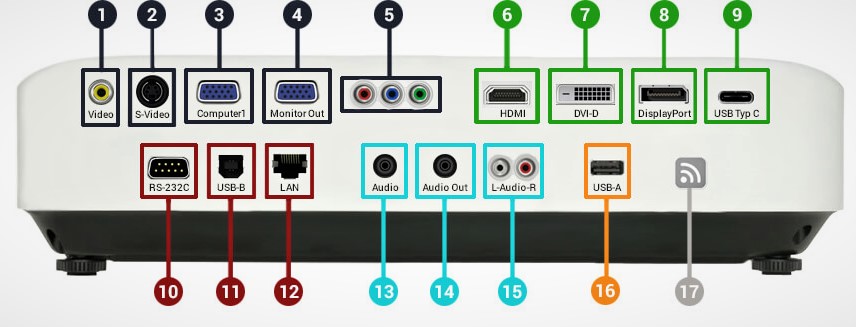
The zoom
If you plan to install your projector in different places, you will not always have control over the size of the screen or the placement of the projector. In these cases, you can use the zoom. By adjusting it, you will not need to move the projector to adjust the image size. The larger the zoom percentage, the wider you can render the image.
Keystone Correction
The trapezoidal correction is a digital process that counteracts the trapezoidal distortion effect. Most of the projectors have an only vertical trapezoidal correction and some others have horizontal and vertical. The "trapezoidal deformation effect" or "trapezoidal distortion"make the projected image appear to be wider at the top when the projector is too low, or wider at one side when the projector is horizontally out of the center.

Vertical keystone correction corrects trapezoidal distortion when the projector is too low or too high but requires horizontal centering, the horizontal correction compensates if the projector is in a horizontal position off-center. Some projectors require a manual adjustment and others calculate it automatically.
The disadvantage of trapezoidal correction is that the resolution is reduced the more it is corrected. To avoid loss of quality the displacement of the lens must be used.
Led lamps
It is the most efficient type of projector lighting and they do not burn, they can fail like any circuit but they have a life of 20,000 hours compared to 5,000 of a typical lamp. Currently, LEDs face two main limitations, less brightness, and a lower color rendering index.
Movable lens
Projectors with movable lenses allow the angle of the lens to be adjusted with respect to the plane of the image. Like the trapezoidal correction, the displacement of the lens can be used to correct the trapezoidal distortion, but unlike the first one, it does not cause loss of resolution. In addition, it can be used to change the position of the image slightly in places where it is needed, or use it to stack and join two or more projectors working at the same time.
Dual Lamp
Some projectors use two (or more) lamps as a cost-effective way to increase brightness.
The “Lens Shift”
It allows you to manually adjust the angle of the lens by moving it up, down or to the sides. The good news with this feature is that it keeps 100% of the resolution of the projected image.
Sound
a video projector is often equipped with speakers. The audibility and power of these should be checked so that they do not involve the purchase of additional speakers. This is an important point for those who want to watch movies or broadcast sports events.
Noise
a cooling system composes these devices. The problem is that a fan can make noise, which is potentially embarrassing for the viewer. As a result, some firms offer silent modes or simply insonated fans.
Brand
Today, it is possible to meet many projector manufacturers on the market; however, not everyone has 4K resolutions. In any case, we advise you to opt for the product of a known brand. This way, you can ensure high quality and good consumer service.
Some of the most famous manufacturers are BenQ, Epson, Sony, Panasonic, and LG. Above all BenQ has an excellent quality/price ratio, so it is one of the brands to consider. Another noteworthy manufacturer is Optoma, as its products are designed primarily for video game players.
What are the advantages and disadvantages of 4K projectors?
With a 4K projector, it is possible to have a superior image quality on a screen larger than that of a normal television: in this way you can experience a better immersion. Moreover, since the projectors are light and small instruments, they can be transported to many places.
Obviously, all this is to add to the fact that probably you will need audio equipment and that sometimes you will have to replace the lamps (and they are not very cheap). To learn about the advantages and disadvantages of these devices, you can refer to this table.
- Greater immersiveness
- You can choose whether to change the screen size
- They take up less space than televisions
- Very simple installation and use
- Possibility to transport them easily from one room to another
- They are very versatile
- The bulb needs to be replaced from time to time
- They take longer to turn on than a TV or monitor
- You need to buy an independent audio device
Cheapest 4K Projectors FAQs
What exactly are 4K projectors?
A projector is an electronic device that, through light and a lens system, projects images on the surface to which it is pointed. 4K projectors are tools that offer a higher image resolution than Full HD, with around 4000 pixels of horizontal resolution.
4K technology is an evolution of Full HD technology. Full HD video devices display 2 million pixels on the screen while 4K technology offers images with more than 8 million pixels.
- The resolution of the 4K is 3840 x 2160 pixels for most devices sold on the market under the name of 4K or UHD.
- UHD is actually devices that are a bit below the true resolution of 4K but still 2 to 3 times larger than Full HD.
Beware, the "real" 4K offers a resolution of 4096 x 2180 pixels that are found very rarely on the projectors on the market (because more expensive).
Some 4K projectors offer enhanced visual effects that are not found on entry-level projectors.
Who should buy a 4K projector?
Without a doubt, there are many projector applications that make them excellent substitutes for televisions and monitors (for some uses). All this without forgetting their versatility and the excellent quality of the image they can offer.
These are ideal devices for bars and cafés but also for discos and showrooms. They can be used for professional presentations related to graphic design, engineering or architecture, but also for those who want to have a small cinema at home.
Do you need a screen for a 4K projector?
Generally, images can be projected onto a gray or white wall, even better if it is opaque. However, if you want to invest in a 4K projector, it doesn't make much sense not to use the proper screen (which, moreover, doesn't cost much). In fact, if you don't do that, you will lose most of the image quality.
What advantages does a 4K video projector offer over a 4K television?
The advantage of a 4K video projector compared to a 4K TV is also the projection surface, indeed some video projectors allow projection surfaces that are up to 8 meters diagonals. Can you imagine a 4K image on a surface of this size? the rendering is beautiful, no need to go to the cinema!
The mobility of the device is also to be taken into account. It is easier to move a 3kg device on average than a TV that is much bulkier. It becomes possible to transport your projector with you, on vacation or with friends.
“True” 4K or “false” 4K?
To propose real 4k (thus resolution of 4096 x 2180 pixels) is technically complicated. Indeed the technology used by video projectors is more complex than that of televisions and it is, therefore, more expensive to implement 4K technology. The projectors use chips to restore the image (DLP, LCD, 3LCD ...). The size of the pixels inside these chips is extremely small, which explains their higher manufacturing cost than televisions.
Sony has managed to offer video projectors with real 4K (or native 4K) for several years but they remain quite expensive and often reserved for purists.
To compensate for these production costs manufacturers have found techniques to offer higher resolutions to Full HD in their video projector. Manufacturers like Epson, JVC use "Shifting" techniques. For LCD video projectors we speak of 4K enhanced at Epson or e-shit for JVC. To keep it simple, these manufacturers keep the standard 1080p chips but cut the 4K image source into 2 x 1080p images that are offset vertically and horizontally with respect to each other. The effect is to get closer to the appearance of a 4K image with fewer pixels.
For DLP video projectors there are also similar methods.
It is, therefore, necessary to understand the different renditions of 4K according to the devices and manufacturers because the manufacturing costs are not the same if one is in the case of a device in native 4K or in 4K calculated by the video projector. The native will always have a better rendering but will always be more expensive. It must be realized, however, that the difference in rendering between a native 4K projector and a video projector with e-shift technology or similar is very difficult to see with the naked eye. To compare and see a difference it will sometimes approach a few inches from the screen if the budget is limited the choice will be made quickly.
Conclusion
Until recently, there were not much 4K content; moreover, the high prices of 4K projectors made these devices inaccessible to most of the public. However, in recent years the price has dropped significantly and, at the same time, the contents in 4K format have increased.
So, if you are thinking of buying the cheapest 4K projector, there are many options available to you: before choosing it, you have to ask yourself what you will use it for. Once you have found an answer, you can begin to consider other issues, such as the type of projector best suited to you and its brightness and contrast.
Finally, if this guide was useful to you in the selection process, share it on your social profiles, or leave us a comment.
